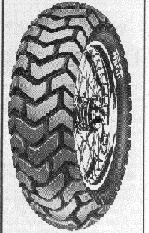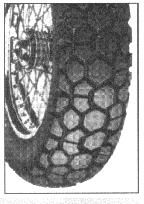TDM850
DUAL SPORT OF COURSE
Part One
BY STEVEN "SCOOTER SCUM" JOHNSON
Originally Published in the Tedious Quarterly.
![]()

Avon Gripster
In this new column, we will expand and enlighten your view of the TDM. The TDM's roots spring from a for "Europe only" motorcycle called the TEnErE 750. The TEnErE was developed for the grueling Dakar to Paris road rally. Road rallies are very popular in Europe and the "rally bikes"have as big a following there just as "race-replica"bikes are popular in the US. Yamaha could see the demand and developed a 5 valve/parallel twin and placed it in dual sport fatigues.
The750 TEnErE would compete with BMW's best selling model, the R100GS and GS/PD. The European division of Yamaha offered the TEnErE in a more street-able version and dubbed it the TDM. The significant differences between the TEnErE and TDM are that TDM added 100cc and gained more HP and torque.
The TDM lost a couple of inches of suspension travel and rims were changed to cast mag wheels over spoke rims. This heritage help explain why the TDM has such long legs relative to average street bikes. The TDM is blessed with a 6" of wheel travel on both ends and a generous amount of ground clearance.
The TDM is considered to be a street bike by most people, but it is also capable of dual sport riding. Some may consider this to be as silly as trials riding with a Goldwing, but in reality the TDM has very similar specifications to the late '60s and early '70s bikes like the trail versions of the Triumph TR6C, BSA, and Honda CL's of old. From personal experience, I have been very pleased with the performance of the TDM for off-road use.

Pirelli MT-60
I tested the TDM with the stock OEM tires off-road with mixed results. I started with a personal benchmark -- the highest 4 wheel drive pass in Colorado, Mosquito Pass.
Mosquito Pass is an old wagon trail between Leadville and Fairplay. The pass starts in Leadville at 10,000 feet and rises to 13,140 feet. The road is rocky, loose, and steep.
My first attempt at the pass was weeks after I purchased the bike. I found that with OEM street tires on the TDM, there was barely sufficient traction to move it up the pass and the bike had to be kept upright in corners and on steep hills.
After this initial experience, I went out to find dual-sport tires. The TDM's rims are very wide by dual-sport standards. After consulting with almost every cycle parts shop in the Denver/Boulder area, I settled on an Avon 110/80-18 tube type Gripster.
This specific Gripster was designed for the rear tire applications, but I ran it as the front tire. I have put 8K miles on the tire with mixed results. The tire cupped when I let the air presure go to zero. I replaced it with a tubeless Pirelli MT-70. The MT-70 has nice deep tread that should provide good long life.
The rear rim is 4" x 17" and the stock tire is 150/70-17 - the same size as the new '95 BMW R1100GS. Last year I could not find a 150 series tire so I settled on a Pirelli 140/80-17 MT-60. With the introduction of the R1100GS, Michelin has introduced the T66 and Metzeler has the Enduro 4 in the 150/70-17.
The dual-sport tires changed the street handling characteristics. The TDM is less stable at speeds above 80 MPH as the dual sport tires flex more and make the TDM squirm during high speed direction changes. I have given up on high speed riding after achieving a life long goal of 140 MPH on a CBR1000, nearly wetting my pants!

Pirelli MT 70
What you lose in high speed stability is nicely gained dirt road stability. The dual-sport tire helps in taming dirt roads, but the physical characteristics of the TDM remain. The addition of dirt tires does not give the capability of power sliding nor the ability to cross deep muddy bogs.
With the change of tires, it does open up roads that once you could only dream of.
This article was originally published in the Tedious Quarterly. For more information, questions, comments or suggestions for articles, please feel free to contact Steve Johnson by e-mail at scum@uswest.net.








